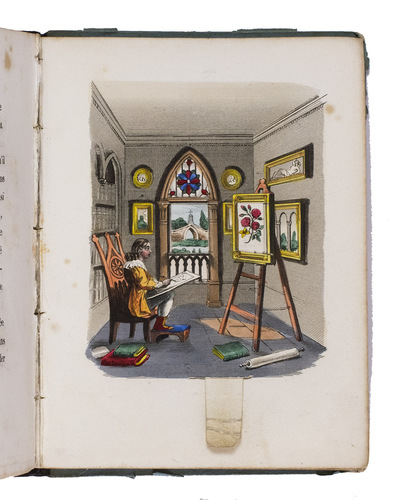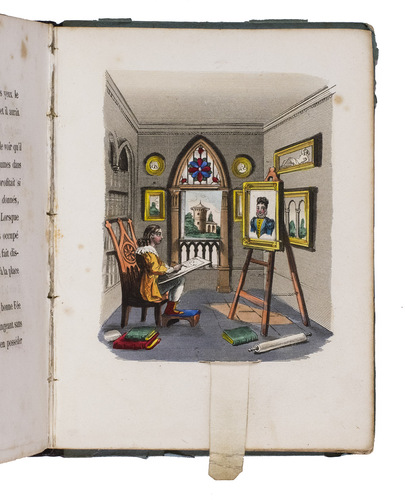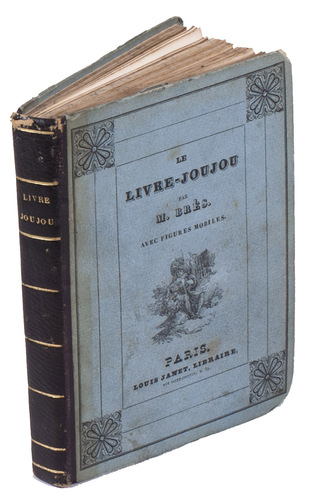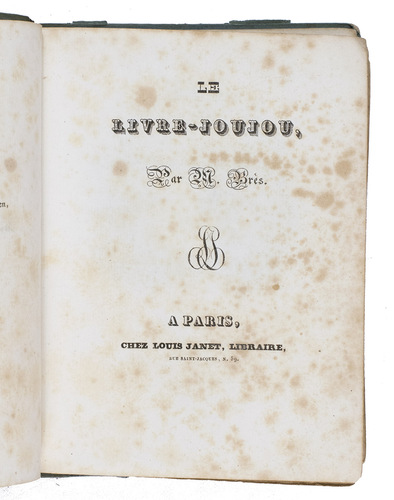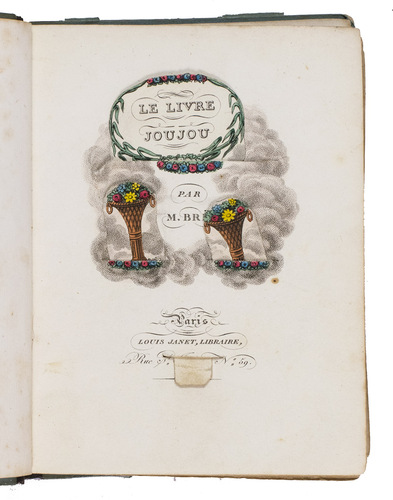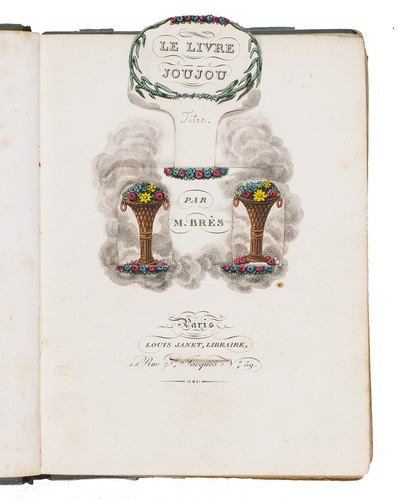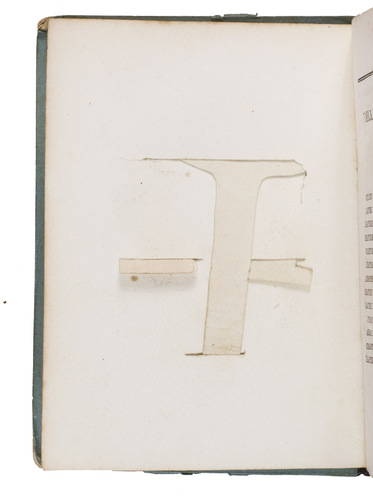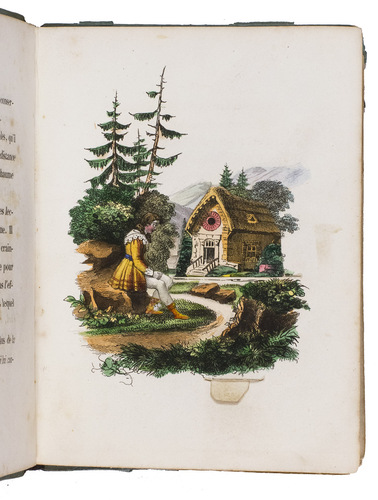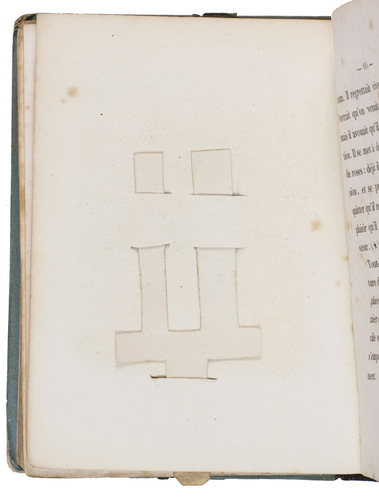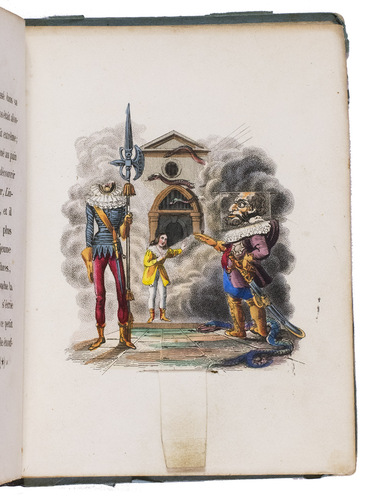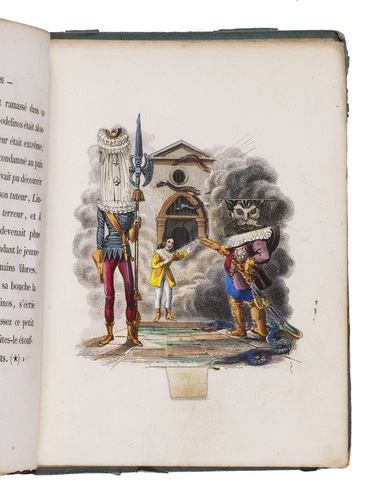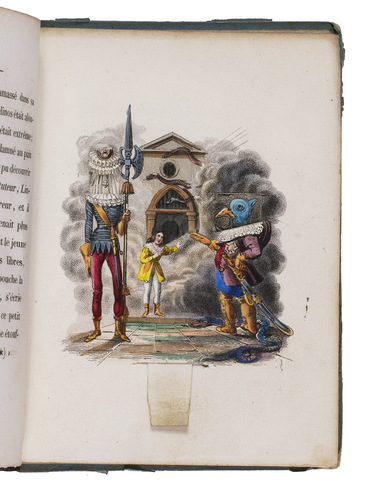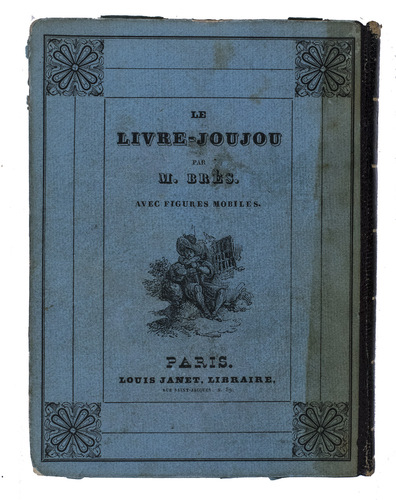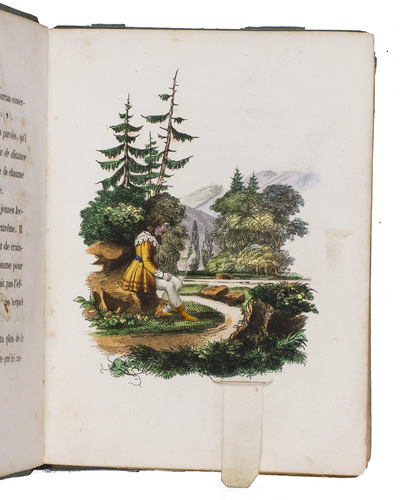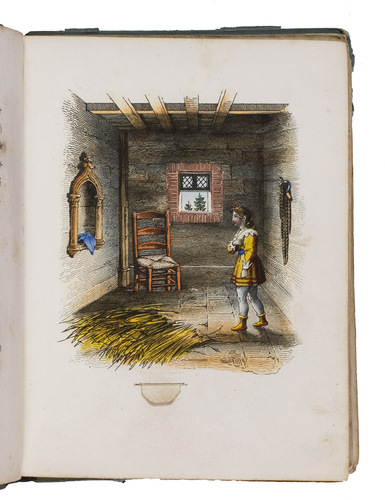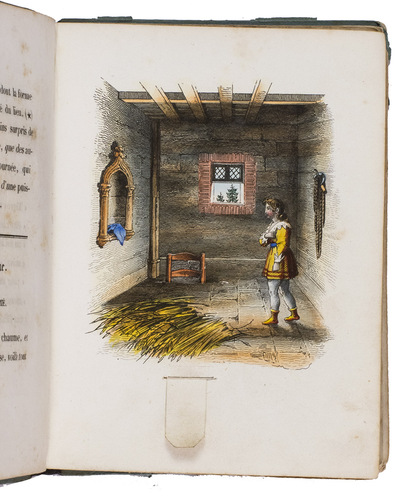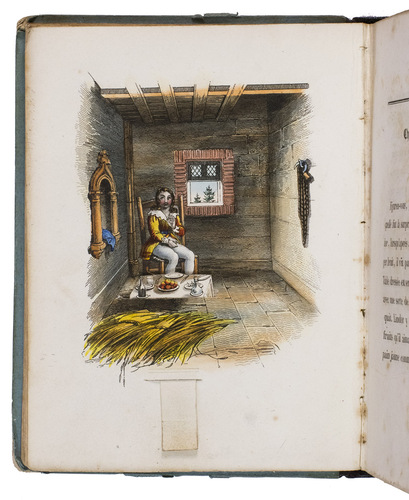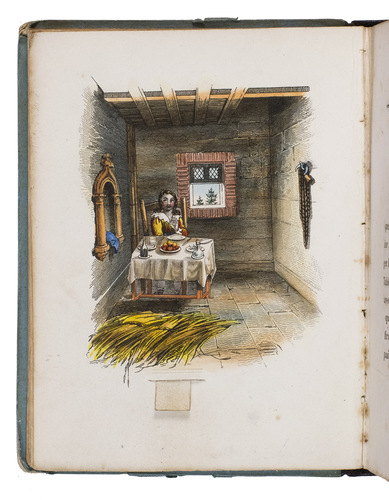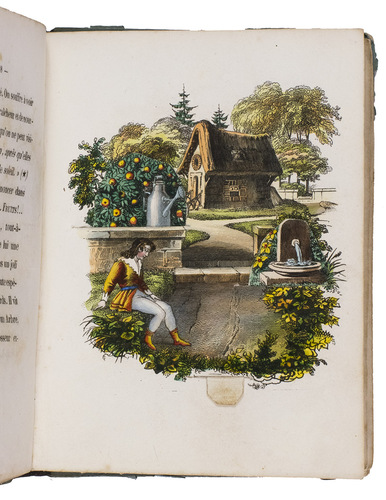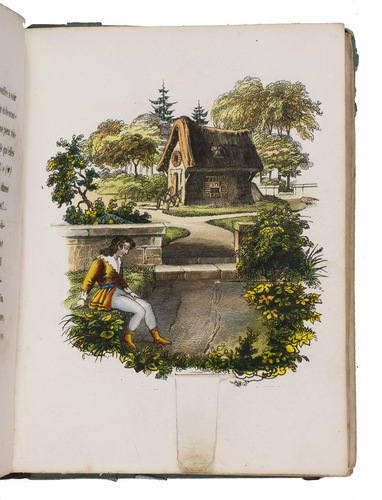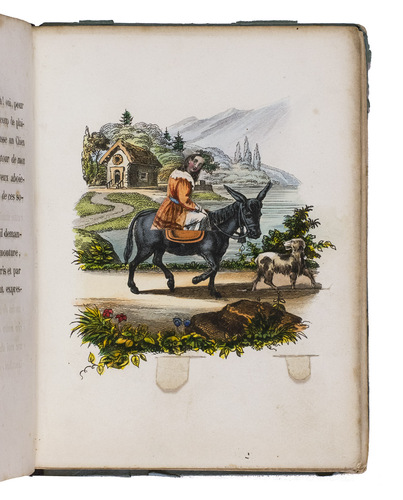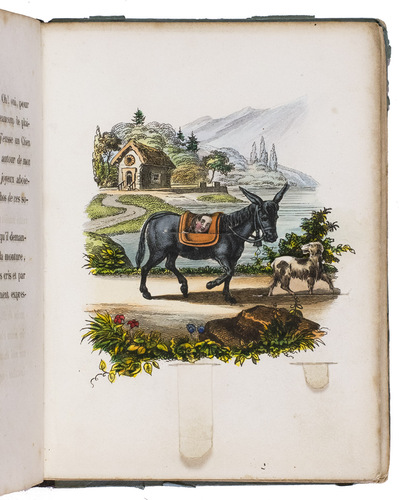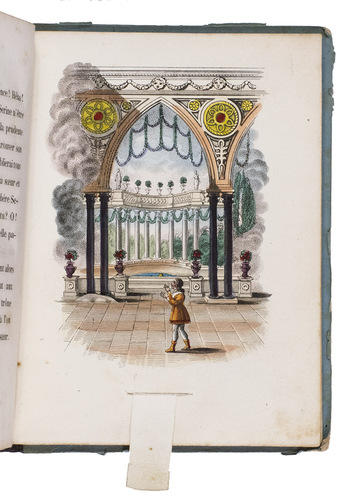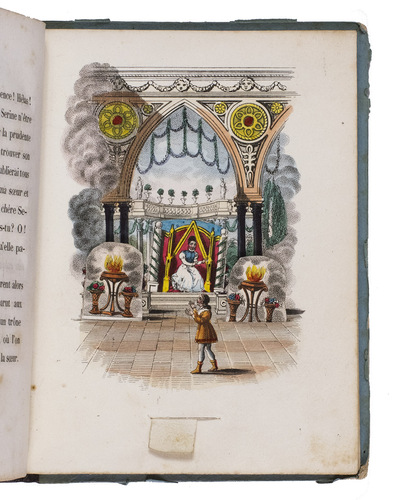BRÈS, Jean-Pierre.
Le livre-joujou.
Paris, Louis Janet, [24 December 1831]. Large 16mo in 8s (14.5 x 11 cm). With a letterpress title-page, an engraved title-page and 12 engraved plates, the engraved title-page and all plates with movable parts (moved with tabs), all 13 engravings and their movable parts hand-coloured for the publisher. Further with a wide variety of decorated types. Publishers original gold-tooled black half sheepskin, original publishers blue paper sides, printed letterpress, the front and back with the same cover-title, with a wood-engraved vignette, marbled edges. [2 blank], “11” [= 6], vii, [1], 157, [3 blank] pp.
€ 22,500
Rare first edition (1831) of what can fairly be called the first childrens pop-up book, the engraved title-page and all twelve plates with movable parts and beautifully hand-coloured for the publisher. The present copy is in the original publishers binding, including the publishers printed paper on the boards, and lacks only one small (8 mm) piece of one figure in one of the movable parts. The book is even rarer in such good condition, for some copies lack some of the moving parts or even entire plates.
Although Erhard Ratdolt published a book with movable parts in 1482, less than three decades after Gutenbergs Bible, early books with movable parts were largely restricted to a few genres: in the 15th- and 16th-century mostly astronomical or cosmological books with volvelles, calendrical calculators, sundials and other scientific instruments; in the 17th-century also anatomical books, where flaps open to reveal the interior human anatomy. Some late 18th-century books showing theatre decor and costumes, with movable flaps, come a bit closer to the present book, but are not integrated into the story and were intended for adults. So books with moving parts for the entertainment of children was a radical idea in the first half of the 19th-century, and the present edition is frequently cited as the first example. It is a fairytale, certainly influenced by classics of the genre, but written for the occasion of the present publication by Jean-Pierre Brès (1782-1832), a well-known author of childrens books. He tells the story of King Sélimour, who goes off to war leaving his children Prince Lindor and Princess Sérine in the care of their uncle Grolino, in fact an evil magician who locks them up and proclaims himself king. The fairy Nira recognises the childrens virtue and rescues them after various adventures. Notably, Brés directs his preliminary "avertissement", not to parents, teachers or other adults but to his "jeunes lecteurs" (young readers), urging them to entertain their friends with this magical book with moving pictures. The plates with moving parts are designed to show the magical events of the fairytale in action, and an asterisk in the text tells the child who presents it to friends when to pull or push a tab to transform the illustration.
With the contemporary engraved booksellers and art supplies sellers ticket of Alphonse Giroux (1776-1848) in the corner of the front paste-down (a shield with an ogive foot and a cusp in the middle of the head, 18 x 16 mm, with the text: "A. Giroux & Cie.|Rue du Coq St. Honoré,|No. 7.|A PARIS"). Girouxs firm traded under that name and at that address from 1806 to 1850. That not only the printed paper on the boards, but also the binding itself, comes from the publisher is apparent from a nearly identical binding (Desse, p. [17], upper illustration), but in red rather than black sheepskin.
The top of the head (from the mouth up, about 8 mm) of one figure in the plate facing p. 126 has been torn off and lost, but all other parts survive in very good condition, with only some of the tabs slightly bent from use (extraordinary, given the fact that the moving parts are not attached and were often lost or worn out with use), the text leaves are foxed throughout, about 20 leaves seriously, but without affecting the engraved title-page or plates. The outer bifolium of quire 8 has separated at the fold, where the sewing has broken (between p. 114 and the facing plate), but the binding is otherwise in good condition, with only the printed paper on the boards slightly discoloured near the spine (where it overlaps the sheepskin), the corners bumped and some small scuff marks at the head and foot of the spine. Overall in remarkably good condition and nearly untrimmed, with (at the foot) some deckle edges and the neatly torn edges where the sheets were divided to make the half-sheet quires (leaf size 14.0 x 10.5 cm). La bibliographie de la France, no. 5974 (24 December 1831; Cotsen Library (19th-century) 183015; Jacques Desse, Linvention du livre à tirettes: Le livre joujou (https://issuu.com/libraires-associes/docs/le_livre_joujou; 7 or 8 copies, at least 2 and probably more lacking parts); Gumuchian 1979; www.themorgan.org/printed-books/65990 &178322; Quérard, Littérature française contemporaine (1846), Brès 9 (vol. II, p. 430); WorldCat 493558922 (3 copies); cf. Pietro Franchi, Apriti libro!: meccanismi, figure, tridimensionalità in libri animati (1998), (ed. unclear); Livres animés (1982), 242 (2nd ed.); not in Die Bilderwelt im Kinderbuch; Göbels, Hundert alte Kinderbücher aus den 19. Jahrhundert; Gottlieb/Morgan Library, Early childrens books (1975: they later acquired a copy); Haining, Movable books; The Osborne collection of early childrens books; for books with movable parts in general, see also Montanaro, Pop-up and movable books, (1993 with a 2000 supplement); www.newberry.org/collection/research-guide/movable-books; Gay Walker, Eccentric books: arts of the book (1988).
Related Subjects:
























